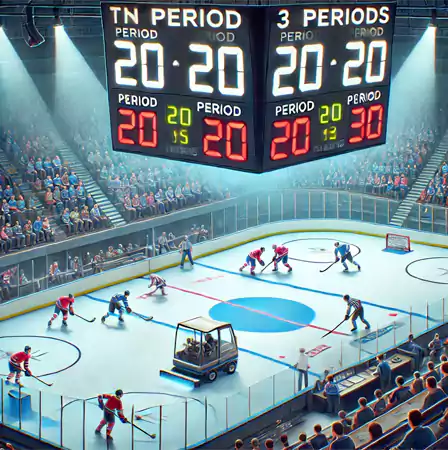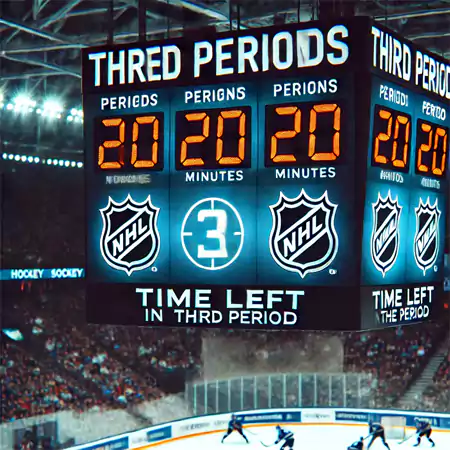How Many Periods Are in Hockey? | Complete Guide to Hockey Game Structure

Hockey is a thrilling and fast-paced sport that keeps fans on the edge of their seats from start to finish. Its rapid shifts in momentum, intense physical play, and strategic depth make it a spectacle to watch. One of the most important aspects of understanding the game is knowing how it’s structured, particularly how many periods are in hockey. While this may seem like a basic question, the answer reveals much about the sport’s flow, the players’ endurance, and the strategies that teams deploy.
Short Summary:
Hockey games are divided into three periods, each lasting 20 minutes. This structure helps maintain the quality of the ice and gives players breaks for recovery. The three-period format is standard across professional leagues like the NHL, international competitions, and college hockey. Overtime rules vary depending on the competition, with the possibility of sudden death or shootouts. This period-based structure enhances game flow and provides opportunities for strategic adjustments between periods.
Key Takeaways:
- Three periods are standard in hockey games, each lasting 20 minutes.
- Intermissions allow for ice resurfacing and player recovery.
- Overtime rules differ by league, with sudden death and shootouts in some cases.
- The period system enhances game strategy, with tactics often evolving between periods.
The Basic Structure: Three Periods in Hockey
In professional hockey, including the NHL (National Hockey League), games are divided into three periods. Each period lasts 20 minutes of regulation time, making up 60 minutes of play in total. After each period, there is an intermission, typically lasting between 15 to 20 minutes, giving players a chance to rest and coaches time to strategize for the next phase of the game.
This three-period structure is a defining characteristic of hockey, setting it apart from other popular sports that are divided into halves or quarters, such as soccer or basketball. The use of periods helps maintain the game’s fast pace while ensuring that players get the breaks they need to recover from the physical demands of the sport.
Historical Development of Periods in Hockey
Hockey wasn’t always divided into three periods. In its early days, hockey was often played in two halves, similar to sports like rugby or soccer. However, this format proved challenging, as the ice quality would deteriorate significantly after just 20 minutes of play. Players would struggle to move the puck efficiently, and the overall quality of the game would drop as the ice surface became rough and uneven.
To solve this problem, the game was divided into three periods, allowing for the ice to be resurfaced twice during the game. This not only improved the quality of the ice, making for a smoother and faster game, but also gave players more time to rest and recover between segments of play. Over time, the three-period format became the standard in professional hockey and remains so today.
Why Are There Three Periods in Hockey?

The decision to divide hockey into three periods isn’t random; it serves several key purposes. One of the primary reasons for this structure is the condition of the ice. Hockey is played on a sheet of ice that requires maintenance to ensure it remains smooth and allows for fast, efficient skating and puck movement. After about 20 minutes of play, the ice surface begins to deteriorate due to the players’ movements, skates cutting into the ice, and the general wear and tear of the game. By dividing the game into three periods, the ice can be resurfaced twice, ensuring that it stays in optimal condition throughout the match.
Additionally, hockey is one of the most physically demanding sports. Players are constantly moving at high speeds, making quick turns, and engaging in physical battles with opponents. The breaks between periods provide players with an opportunity to rest, rehydrate, and recover, ensuring they can perform at their highest level for the duration of the game.
Finally, the three-period structure allows for more strategic adjustments. Coaches can assess their team’s performance after each period and make necessary changes, whether it’s adjusting line combinations, tweaking defensive strategies, or motivating players to push harder in the final stretch of the game.
The Flow of the Game: First, Second, and Third Periods
Each period in a hockey game plays a distinct role in the overall flow of the contest. The strategies and intensity often shift as the game progresses.
- First Period: Setting the Stage
The first period is where teams feel each other out, setting the tone for the rest of the game. Players often start cautiously, trying to avoid early mistakes while assessing their opponents’ strategies. The first period is about building momentum, testing the other team’s defense, and finding ways to gain an early advantage. - Second Period: The Momentum Builder
The second period is typically where the game begins to open up. Teams have settled into their strategies, and now they start to push harder. This period is particularly interesting because of the long change. In hockey, players sit on the bench when they’re not on the ice, and during the second period, the benches are farther from the defensive zone. This can lead to longer shifts and more opportunities for scoring, as players may get caught in situations where they can’t change lines as easily. - Third Period: The Final Push
The third period is often the most intense part of the game, especially if the score is close. Teams that are leading may switch to a more defensive style to protect their lead, while teams that are behind may take more risks in an effort to tie the game. It’s in the third period where many games are won or lost, with teams pulling their goalie for an extra skater in the final minutes if they’re trailing.Overtime: When Three Periods Aren’t Enough
While a standard hockey game consists of three periods, sometimes that’s not enough to determine a winner. If a game is tied at the end of the third period, most leagues will implement overtime to decide the outcome.
- NHL Regular Season Overtime
In the NHL regular season, if the score is tied after three periods, the game goes into a 5-minute sudden-death overtime period. This means that the first team to score during overtime wins the game. Overtime in the regular season is played with 3 skaters on each side instead of the usual 5, which opens up the ice and creates more scoring opportunities. If no team scores during overtime, the game goes to a shootout, where players take turns attempting to score on the opposing goalie. - NHL Playoff Overtime
In the playoffs, the stakes are much higher, and the overtime rules reflect that. If a playoff game is tied after three periods, the teams continue to play 20-minute sudden-death overtime periods until one team scores. There is no shootout in playoff hockey, so games can go on for multiple overtime periods, sometimes lasting several hours. - International and Other Leagues
In international competitions, such as the Olympics or World Championships, the overtime rules may differ slightly depending on the stage of the tournament. In many cases, overtime periods are shorter in the early stages but extend in later rounds, with the final games often using the full sudden-death format similar to the NHL playoffs.
How Many Periods Are in Ice Hockey Across Different Leagues?
The question of how many periods are in ice hockey can be applied across different levels of the sport, and while the answer remains largely the same—three periods—there are some variations in how the periods are structured and how overtime is handled.
- International Ice Hockey
In international competitions, the game format typically follows the same three-period structure as seen in the NHL. Each period is 20 minutes long, with intermissions between periods. However, the rules for overtime and shootouts may vary depending on the tournament. In Olympic or World Championship play, overtime rules may be adjusted based on whether the game is part of the group stage or a knockout round. - College Hockey
In NCAA college hockey, the standard format also includes three periods of 20 minutes. However, overtime rules differ slightly depending on whether it’s a regular-season or postseason game. In the regular season, if a game is tied after three periods, a short overtime is played, typically 5 minutes of sudden death. If no one scores, the game can end in a tie. In the postseason, though, games go into continuous overtime periods until one team scores, similar to the NHL playoffs. - Junior and Youth Leagues
Youth and junior leagues generally follow the same three-period structure, though period lengths may be shorter, depending on the age group. For example, younger players might play 15-minute periods rather than 20 minutes. The overall structure of three periods is consistent, helping young players learn the flow and rhythm of the game.
The Importance of Periods in Hockey Strategy
The structure of hockey into three periods isn’t just about breaking up the game for practical reasons—it plays a vital role in how teams approach their strategy. Coaches and players use the breaks between periods to adjust their tactics based on what happened during the previous 20 minutes. A team that dominated the first period but failed to score might make changes to their offensive lines, while a team that fell behind could focus on tightening their defense.
Teams may also shift their strategies as the game progresses, especially going into the third period. If a team is leading, they may adopt a more defensive style, clearing the puck and focusing on preventing the other team from getting quality scoring chances. Conversely, if a team is trailing, they may take more risks, pulling their goalie for an extra skater in the final minutes of the game in an attempt to tie it up.
Conclusion
In conclusion, hockey is divided into three periods, each lasting 20 minutes. This structure not only helps maintain the ice quality but also provides players with necessary breaks and opportunities for teams to regroup and adjust their strategies. Whether you’re watching the NHL, international ice hockey, or youth leagues, the format of three periods remains a defining feature of the game. Understanding how many periods are in hockey gives you a deeper appreciation for the sport and its unique flow, as well as how teams plan and adapt throughout a match.
FAQs with Keywords
Ans: In hockey, there are three periods. Each period lasts 20 minutes, and there are intermissions between periods for ice resurfacing and player rest.
Ans: A standard hockey game is divided into three periods, making up a total of 60 minutes of regulation play. Overtime can be added if the game is tied after the third period.
Ans: The three-period format helps maintain the ice quality, gives players time to rest, and allows coaches to adjust strategies between periods. It ensures a high-paced game with short breaks for recovery.
Ans: In ice hockey, there are always three periods of regulation time. If the game is tied after the third period, overtime may be played, depending on the league or tournament rules.
Ans: Yes, most hockey leagues, including the NHL, college hockey, and international competitions, follow the standard format of three periods. However, the length of overtime and specific rules may vary between leagues.
Ans: Each period in a hockey game is 20 minutes of stop-time play. This means the clock stops whenever play is halted due to goals, penalties, or other stoppages.
Ans: In the NHL regular season, if the game is tied after three periods, teams will play a 5-minute overtime followed by a shootout if necessary. However, in playoff games, overtime periods continue until a team scores.
Ans: Even in youth or junior hockey, the game is generally divided into three periods. However, the duration of each period may be shorter than in professional leagues.
Ans: Yes, overtime is considered an additional period in hockey. In the NHL, regular-season overtime lasts 5 minutes, while playoff overtime continues with 20-minute periods until a goal is scored.
Ans: Intermissions between periods allow the ice to be resurfaced, ensuring it remains in good condition for the players. It also gives players time to rest and recover before the next period.
- Short Summary:
- Key Takeaways:
- The Basic Structure: Three Periods in Hockey
- Historical Development of Periods in Hockey
- Why Are There Three Periods in Hockey?
- The Flow of the Game: First, Second, and Third Periods
- How Many Periods Are in Ice Hockey Across Different Leagues?
- The Importance of Periods in Hockey Strategy
- Conclusion
- FAQs with Keywords









